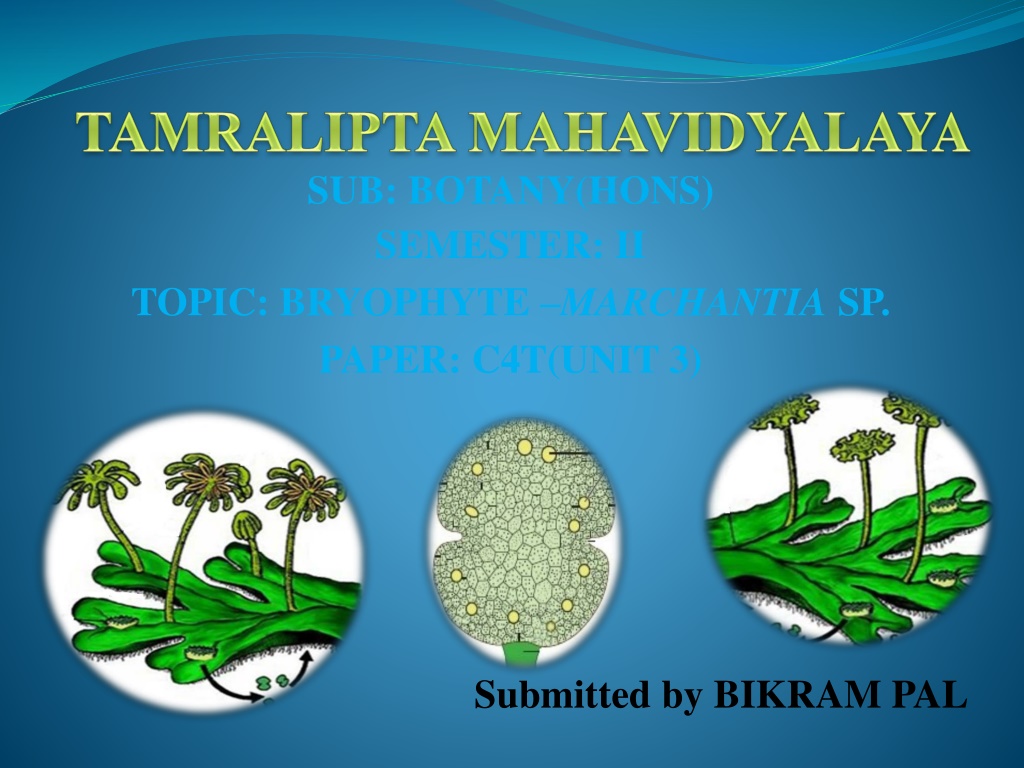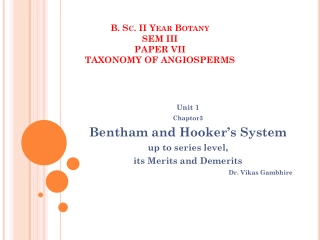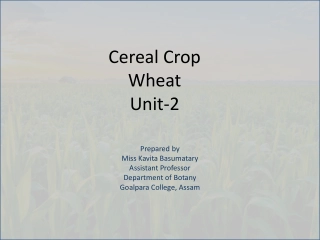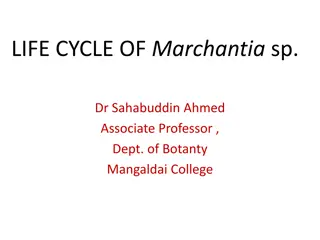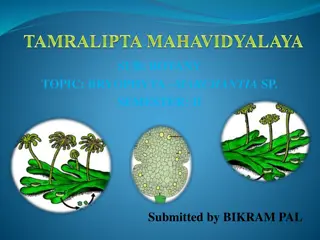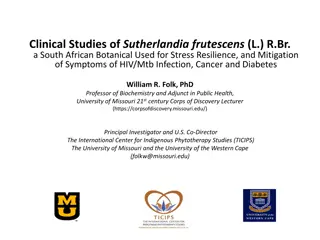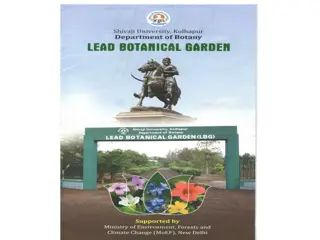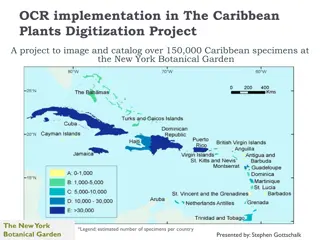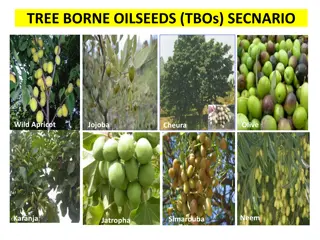Understanding Bryophyte Marchantia: Botanical Insights
Marchantia, a thalloid bryophyte, exhibits dichotomous branching and a gametophyte-dominant life cycle. It is dioecious with distinct male and female thalli bearing antheridia and archegonia. With around 65 global species, including common ones like M. polymorpha, it thrives in moist, sandy habitats. Its gametophyte features ventral scales and unicellular rhizoids for water and nutrient absorption. The sporophyte relies on the gametophyte and aids spore dispersal through elaters. Reproduction involves both vegetative, like adventitious branches, and sexual methods.
Download Presentation

Please find below an Image/Link to download the presentation.
The content on the website is provided AS IS for your information and personal use only. It may not be sold, licensed, or shared on other websites without obtaining consent from the author. Download presentation by click this link. If you encounter any issues during the download, it is possible that the publisher has removed the file from their server.
E N D
Presentation Transcript
SUB: BOTANY(HONS) SEMESTER: II TOPIC: BRYOPHYTE MARCHANTIA SP. PAPER: C4T(UNIT 3) Submitted by BIKRAM PAL
INTRODUCTION: Marchantia is a thalloid, dorsiventrally flattened, dichotomously branched, lower bryophytes. The main plant body is gametophyte which is independent and bears both antheridium an archegonium on the separate thallus thats why Marchantia is dioecious or heterothallic. The unicellular rhizoids and multicellular scale are present on the gametophyte. The sporophytic plant body is without chloroplast and depends on the gametophyte. The sporophytic plant body contains spore and elaters that are responsible for spore dispersal. The spore tetrad germinates and forms new gametophytic plant body. A B Fig.1. A: Male Thallus, B. Female Thallus.
Systematic Position: Division: Bryophyta Class: Hepatiopsida Order: Marchantiales Family: Marchantiaceae Genus: Marchantia Species: M. polymorpha. Total No of Species: There are total about 65 species distributed globally. out of 65 there are about 11 species occurs in India. Common Indian Species: 1. Marchantia polymorpha, 2. M. Palmata, 3.M. Nepalensis etc. Distribution and Habitat: Marchantia is cosmopoliton in distribution. It prefers to grow on moist, cool and sandy environment and in the sides of streams, springs and swamps.
Gametophytic plant body: External structure: Dichotomously dorsiventrally flattened thalloid structure. Midrib present on the upper surface of the thallus. Presence of apical notch or growing point i.e. the groing part of the thallus. Ventral surface bears scales that protect the growing point of desiccation and unicellular rhizoids (smooth walled and tuberculated) that absorbs the water and nutrients from soil. The dorsal surface bears antheriodiophore with antheridium with arechegonium. branched, prostrate, A the thallus from B and archegioniophore Fig.2: A. Male and B. Female plant of Marchantia polymorpha.
Internal structure: Internaly Marchantia thallus contain two regions- Photosynthetic region. Upper dorsal chloroplasts. Air chember is present on the upper epidermis. simple or branched filaments aries from the floor of the air chember that connects with atmosphere throughairpores. Lower epidermis bears unicellular rhizoid and multicellularscales. storage region present just below the air chembers that contain parenchyma cells without chloroplast.The cells of storage region contain starch or proteingranulesoroil or mucilage. and Storage epidermis contain Chloroplast containg A thin walled C D B Fig.3:A. Internal str. Of thallus, B. Single scale, C Smooth D. Tuberculated rhizoid
REPRODUCTION: Marchantia reproduces both vegetative and sexually. A. Vegetative Reproduction: 1. By adventitious branches: Adventitious branches aries from the ventral side of the thallus or reproductive buds. The branches separate from the parent thallus and grow into new thallus. 2. By progressive death: When progressive death and decay of the thallus reaches dichotomy, the two lobe separates and each separation lobe froms new thallus. 3. By gammae: gammae are the specialised asexual multicellular bodies present within the cup shaped structure called gemma cup that is present in the dorsal surface of the thallus. Mature gammae release from the gemma cup, germinates and form a new thallus. A B C Fig.4: A. Adventitious branches, B. Progressive death of the thallus, C. Gemma cup and gammae.
B. Sexual Reproduction: Marchantia is dioecious or heterothallic that means male sex organ antheridium and female sex organ archegonium develope on separate plants. A. Antheridiophore and antheridia: Antheridiophore is a stalk bearing at its appex a convex structure. Numerous develop in a acropetal manner with in the disc. Each antheridia present within a chember like antheridial chembes. antheridium has a short stalk and a globular body covered by jacket which encloses a number of sperm mother cells. A single sperm mother cell forms two androcytes, develops a biciliated antherozoid. disc antheridium shaped A structure called mature A B C each of which Fig.5: A. Antheridiophore with antheridium, B. Single Antheridium, C . sperm sperm or
B. Archegoniophore and archegonia: The archegoniophore is comprised of a stalk and a disc that bears 9 rays. About 12-14 archegonia are arranged in a single row on each ray of the disc. A mature archegonium is a pendulous flask- shaped structure with a short stalk, which attaches to the lower (ventral) surface of the archegonial disc. A single archegonium has a basal swollen venter containing an egg cell, a ventral canal cell and a row of neck canal cells inside the elongated neck. A B Fig.6: A. Archegonium with archegoniophore, B. Archegonium
Fertilisation of Archegonium: The fertilisation of Marchantia is dependent upon the presence of water. The neck canel cells and ventral canal cell of archegonia disintegrate to form a mucilaginous mass. The mucilage imbibes water, swells and carries the sperm to the egg of the archegonia. The fertilised egg enlarges in size and form the oospore or zygote which is the mother cell of the sporophytic generation.
Structure of the Mature Sporophyte: The mature sporophyte of Marchantia is differentiated into three parts foot, seta and capsule. (a) Foot: It is an expanded bulbous mass of cells at the base of the sporogonium, serves as an absorbing and anchoring organ. It absorbs nutrients from the gametophyte. (b) Seta: It is a slightly elongated stalk that connects the foot to the capsule. The cells are parenchymatous and elongated lengthwise. Thus, seta increases in length and pushes the mature capsule out of the calyptra. (c) Capsule: It is a yellow-coloured spherical structure, contains numerous spores and elaters. The capsule is protected by three coverings viz. Calyptra, perigynium and perichaetium. Fig.7: Mature Sporophytic plant body
Dehiscence of the Capsule: The sporogonium (capsule) gets dried and splits longitudinally into a variable number of longitudinal lobes. These lobes extend from the apex to the middle of the capsule. The discharge and dispersal of sport to the air are assisted by the coiling and uncoiling of the elaters due to their hygroscopic nature. The spores are almost rounded and are very minute in size with a thin inner intine and a slightly thicker outer exine. In some species an additional layer called perispore is also found outside the exine. The new Gametophytic plant: jacket of the hanging mature Fig.8: Stages of germination of Marchantia spores. Spore is the first cell of the gametophyte which germinates to form a new gametophytic plant body. Marchantia is a dioecious plant. Out of each spore tetrad two spores grow into two male plants and the two into female plants.
Alternation of Generation: Marchantia shows gametophytic(n) and sporophytic (2n) generation in their life cycle. The gametophtic generation turns into sprophytic generation through fertilization and sporophytic into gametophytic generation through meiosis Fig.9: Alternation of generation.
REFERENCES: 1. A Text Book of Botany(Vol-I)-Hait. 2. Archegoniates- Baman chandra acharya.
